University HRM4003 Report: Contemporary HR Practices Impact Analysis
VerifiedAdded on 2023/06/03
|14
|4006
|477
Report
AI Summary
This report provides an in-depth analysis of contemporary Human Resource (HR) practices and their impact on employee motivation and productivity. It begins by defining HR practices and their strategic importance in aligning human capital with organizational goals. The report then delves into specific practices, including performance appraisal, training and development, and reward management, examining their effects on employee behavior and organizational outcomes. Performance appraisal is discussed as a tool for evaluating and improving employee performance, while training and development are highlighted as crucial for enhancing employee skills and adaptability. Reward management is presented as a means of aligning employee expectations with organizational goals and incentivizing performance. The report explores the effects of these practices on employee motivation and productivity, and the importance of creating a transparent and trusting work environment. The report also references case studies, such as Safaricom and Siemens, to illustrate the practical application and impact of these HR practices. The report concludes by emphasizing the importance of these practices in achieving organizational objectives and gaining a competitive advantage.
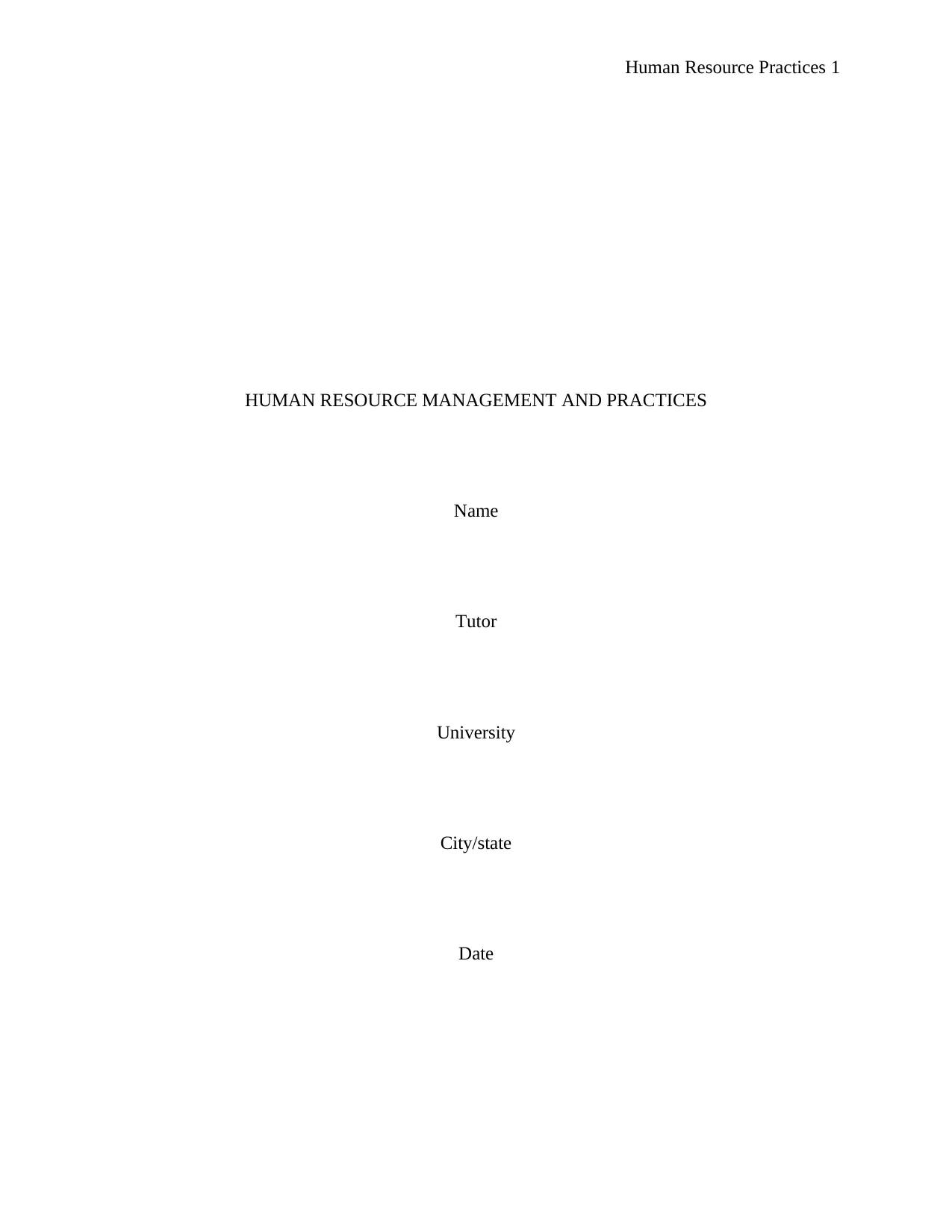
Human Resource Practices 1
HUMAN RESOURCE MANAGEMENT AND PRACTICES
Name
Tutor
University
City/state
Date
HUMAN RESOURCE MANAGEMENT AND PRACTICES
Name
Tutor
University
City/state
Date
Paraphrase This Document
Need a fresh take? Get an instant paraphrase of this document with our AI Paraphraser
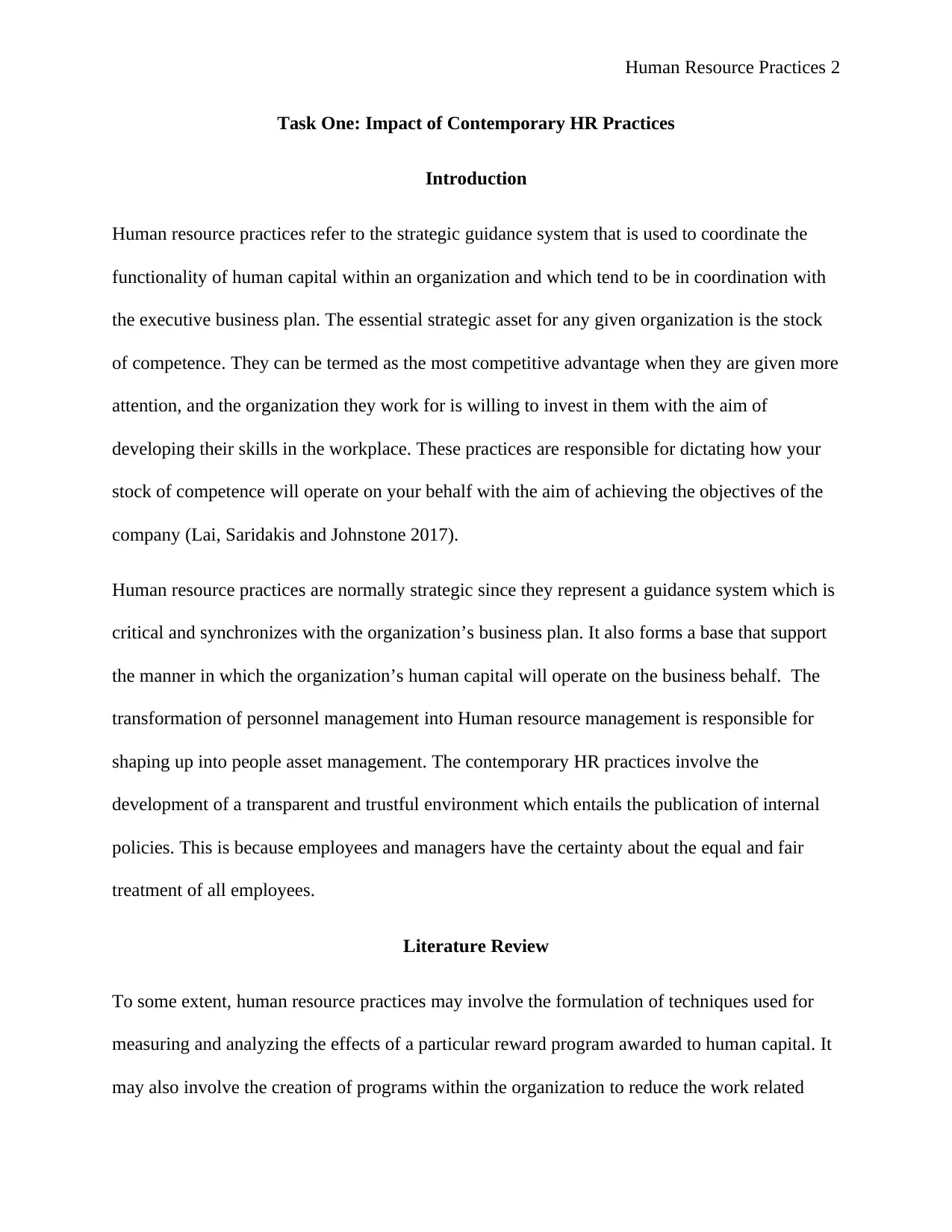
Human Resource Practices 2
Task One: Impact of Contemporary HR Practices
Introduction
Human resource practices refer to the strategic guidance system that is used to coordinate the
functionality of human capital within an organization and which tend to be in coordination with
the executive business plan. The essential strategic asset for any given organization is the stock
of competence. They can be termed as the most competitive advantage when they are given more
attention, and the organization they work for is willing to invest in them with the aim of
developing their skills in the workplace. These practices are responsible for dictating how your
stock of competence will operate on your behalf with the aim of achieving the objectives of the
company (Lai, Saridakis and Johnstone 2017).
Human resource practices are normally strategic since they represent a guidance system which is
critical and synchronizes with the organization’s business plan. It also forms a base that support
the manner in which the organization’s human capital will operate on the business behalf. The
transformation of personnel management into Human resource management is responsible for
shaping up into people asset management. The contemporary HR practices involve the
development of a transparent and trustful environment which entails the publication of internal
policies. This is because employees and managers have the certainty about the equal and fair
treatment of all employees.
Literature Review
To some extent, human resource practices may involve the formulation of techniques used for
measuring and analyzing the effects of a particular reward program awarded to human capital. It
may also involve the creation of programs within the organization to reduce the work related
Task One: Impact of Contemporary HR Practices
Introduction
Human resource practices refer to the strategic guidance system that is used to coordinate the
functionality of human capital within an organization and which tend to be in coordination with
the executive business plan. The essential strategic asset for any given organization is the stock
of competence. They can be termed as the most competitive advantage when they are given more
attention, and the organization they work for is willing to invest in them with the aim of
developing their skills in the workplace. These practices are responsible for dictating how your
stock of competence will operate on your behalf with the aim of achieving the objectives of the
company (Lai, Saridakis and Johnstone 2017).
Human resource practices are normally strategic since they represent a guidance system which is
critical and synchronizes with the organization’s business plan. It also forms a base that support
the manner in which the organization’s human capital will operate on the business behalf. The
transformation of personnel management into Human resource management is responsible for
shaping up into people asset management. The contemporary HR practices involve the
development of a transparent and trustful environment which entails the publication of internal
policies. This is because employees and managers have the certainty about the equal and fair
treatment of all employees.
Literature Review
To some extent, human resource practices may involve the formulation of techniques used for
measuring and analyzing the effects of a particular reward program awarded to human capital. It
may also involve the creation of programs within the organization to reduce the work related
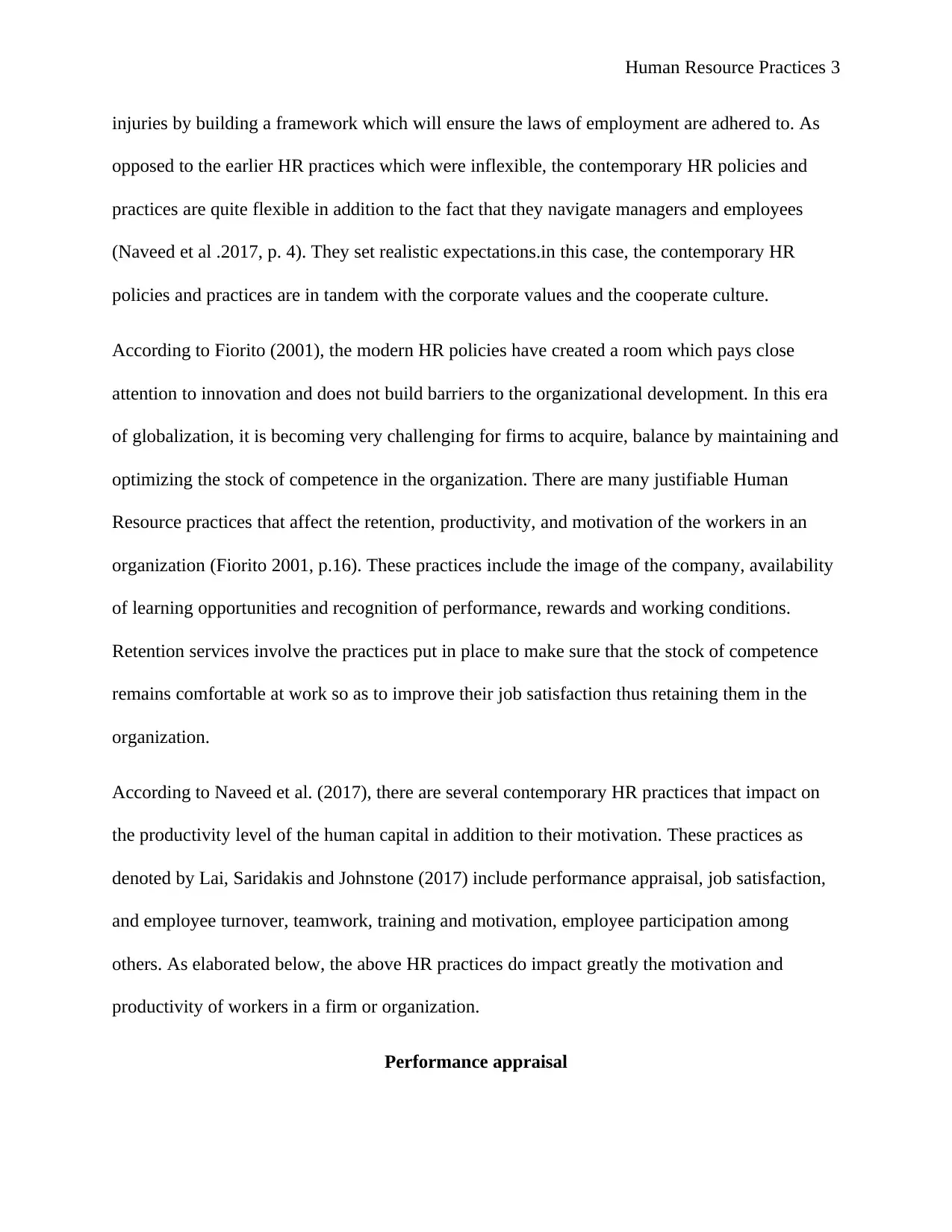
Human Resource Practices 3
injuries by building a framework which will ensure the laws of employment are adhered to. As
opposed to the earlier HR practices which were inflexible, the contemporary HR policies and
practices are quite flexible in addition to the fact that they navigate managers and employees
(Naveed et al .2017, p. 4). They set realistic expectations.in this case, the contemporary HR
policies and practices are in tandem with the corporate values and the cooperate culture.
According to Fiorito (2001), the modern HR policies have created a room which pays close
attention to innovation and does not build barriers to the organizational development. In this era
of globalization, it is becoming very challenging for firms to acquire, balance by maintaining and
optimizing the stock of competence in the organization. There are many justifiable Human
Resource practices that affect the retention, productivity, and motivation of the workers in an
organization (Fiorito 2001, p.16). These practices include the image of the company, availability
of learning opportunities and recognition of performance, rewards and working conditions.
Retention services involve the practices put in place to make sure that the stock of competence
remains comfortable at work so as to improve their job satisfaction thus retaining them in the
organization.
According to Naveed et al. (2017), there are several contemporary HR practices that impact on
the productivity level of the human capital in addition to their motivation. These practices as
denoted by Lai, Saridakis and Johnstone (2017) include performance appraisal, job satisfaction,
and employee turnover, teamwork, training and motivation, employee participation among
others. As elaborated below, the above HR practices do impact greatly the motivation and
productivity of workers in a firm or organization.
Performance appraisal
injuries by building a framework which will ensure the laws of employment are adhered to. As
opposed to the earlier HR practices which were inflexible, the contemporary HR policies and
practices are quite flexible in addition to the fact that they navigate managers and employees
(Naveed et al .2017, p. 4). They set realistic expectations.in this case, the contemporary HR
policies and practices are in tandem with the corporate values and the cooperate culture.
According to Fiorito (2001), the modern HR policies have created a room which pays close
attention to innovation and does not build barriers to the organizational development. In this era
of globalization, it is becoming very challenging for firms to acquire, balance by maintaining and
optimizing the stock of competence in the organization. There are many justifiable Human
Resource practices that affect the retention, productivity, and motivation of the workers in an
organization (Fiorito 2001, p.16). These practices include the image of the company, availability
of learning opportunities and recognition of performance, rewards and working conditions.
Retention services involve the practices put in place to make sure that the stock of competence
remains comfortable at work so as to improve their job satisfaction thus retaining them in the
organization.
According to Naveed et al. (2017), there are several contemporary HR practices that impact on
the productivity level of the human capital in addition to their motivation. These practices as
denoted by Lai, Saridakis and Johnstone (2017) include performance appraisal, job satisfaction,
and employee turnover, teamwork, training and motivation, employee participation among
others. As elaborated below, the above HR practices do impact greatly the motivation and
productivity of workers in a firm or organization.
Performance appraisal
⊘ This is a preview!⊘
Do you want full access?
Subscribe today to unlock all pages.

Trusted by 1+ million students worldwide
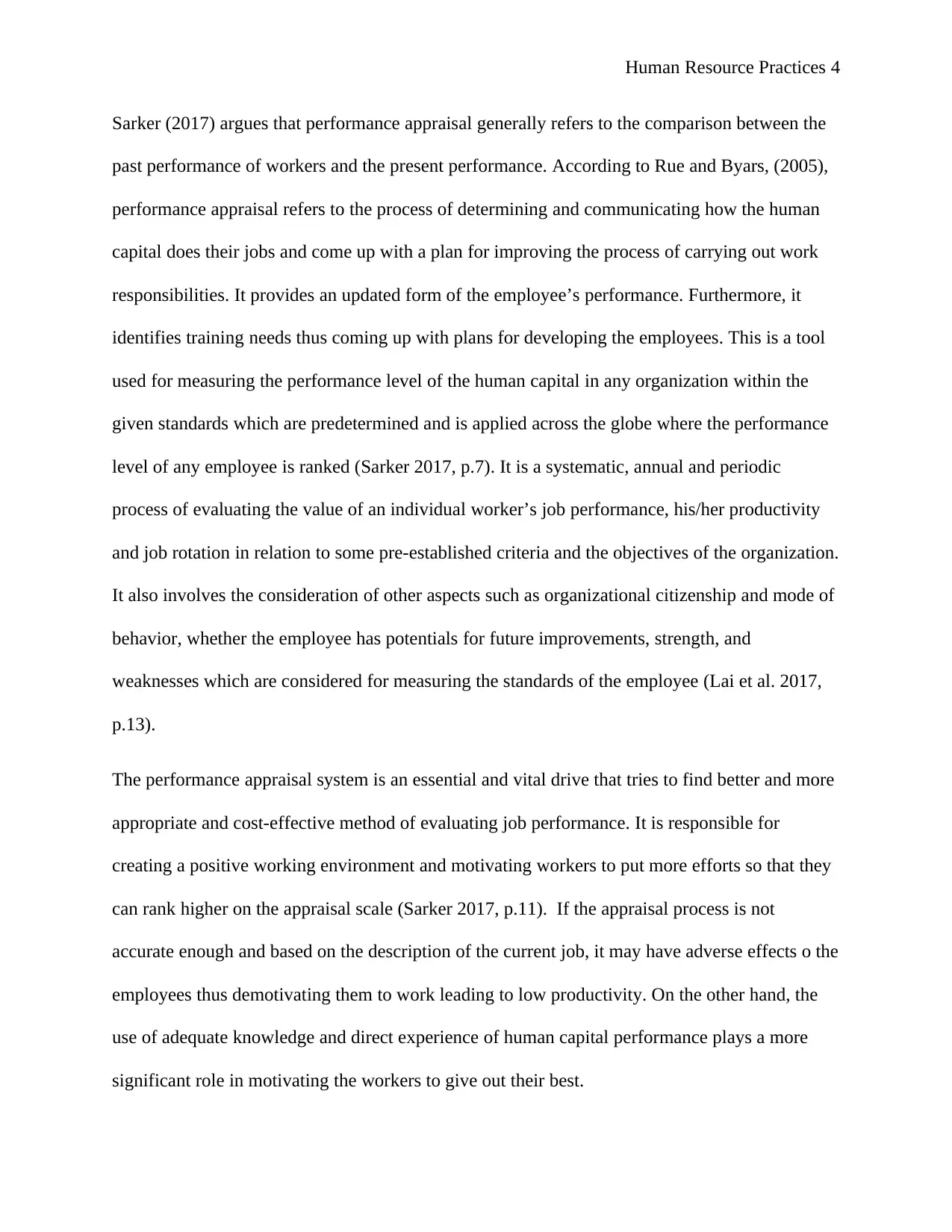
Human Resource Practices 4
Sarker (2017) argues that performance appraisal generally refers to the comparison between the
past performance of workers and the present performance. According to Rue and Byars, (2005),
performance appraisal refers to the process of determining and communicating how the human
capital does their jobs and come up with a plan for improving the process of carrying out work
responsibilities. It provides an updated form of the employee’s performance. Furthermore, it
identifies training needs thus coming up with plans for developing the employees. This is a tool
used for measuring the performance level of the human capital in any organization within the
given standards which are predetermined and is applied across the globe where the performance
level of any employee is ranked (Sarker 2017, p.7). It is a systematic, annual and periodic
process of evaluating the value of an individual worker’s job performance, his/her productivity
and job rotation in relation to some pre-established criteria and the objectives of the organization.
It also involves the consideration of other aspects such as organizational citizenship and mode of
behavior, whether the employee has potentials for future improvements, strength, and
weaknesses which are considered for measuring the standards of the employee (Lai et al. 2017,
p.13).
The performance appraisal system is an essential and vital drive that tries to find better and more
appropriate and cost-effective method of evaluating job performance. It is responsible for
creating a positive working environment and motivating workers to put more efforts so that they
can rank higher on the appraisal scale (Sarker 2017, p.11). If the appraisal process is not
accurate enough and based on the description of the current job, it may have adverse effects o the
employees thus demotivating them to work leading to low productivity. On the other hand, the
use of adequate knowledge and direct experience of human capital performance plays a more
significant role in motivating the workers to give out their best.
Sarker (2017) argues that performance appraisal generally refers to the comparison between the
past performance of workers and the present performance. According to Rue and Byars, (2005),
performance appraisal refers to the process of determining and communicating how the human
capital does their jobs and come up with a plan for improving the process of carrying out work
responsibilities. It provides an updated form of the employee’s performance. Furthermore, it
identifies training needs thus coming up with plans for developing the employees. This is a tool
used for measuring the performance level of the human capital in any organization within the
given standards which are predetermined and is applied across the globe where the performance
level of any employee is ranked (Sarker 2017, p.7). It is a systematic, annual and periodic
process of evaluating the value of an individual worker’s job performance, his/her productivity
and job rotation in relation to some pre-established criteria and the objectives of the organization.
It also involves the consideration of other aspects such as organizational citizenship and mode of
behavior, whether the employee has potentials for future improvements, strength, and
weaknesses which are considered for measuring the standards of the employee (Lai et al. 2017,
p.13).
The performance appraisal system is an essential and vital drive that tries to find better and more
appropriate and cost-effective method of evaluating job performance. It is responsible for
creating a positive working environment and motivating workers to put more efforts so that they
can rank higher on the appraisal scale (Sarker 2017, p.11). If the appraisal process is not
accurate enough and based on the description of the current job, it may have adverse effects o the
employees thus demotivating them to work leading to low productivity. On the other hand, the
use of adequate knowledge and direct experience of human capital performance plays a more
significant role in motivating the workers to give out their best.
Paraphrase This Document
Need a fresh take? Get an instant paraphrase of this document with our AI Paraphraser
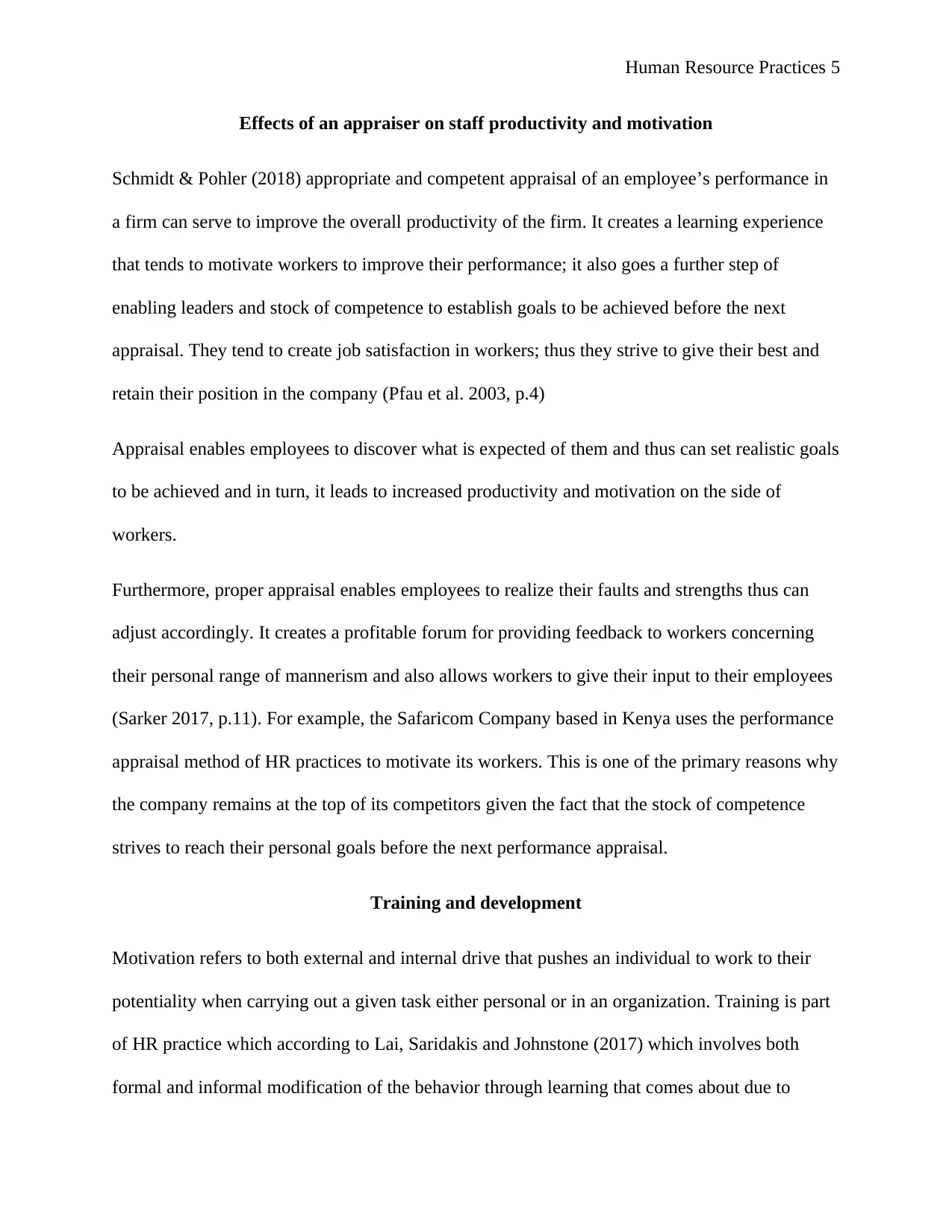
Human Resource Practices 5
Effects of an appraiser on staff productivity and motivation
Schmidt & Pohler (2018) appropriate and competent appraisal of an employee’s performance in
a firm can serve to improve the overall productivity of the firm. It creates a learning experience
that tends to motivate workers to improve their performance; it also goes a further step of
enabling leaders and stock of competence to establish goals to be achieved before the next
appraisal. They tend to create job satisfaction in workers; thus they strive to give their best and
retain their position in the company (Pfau et al. 2003, p.4)
Appraisal enables employees to discover what is expected of them and thus can set realistic goals
to be achieved and in turn, it leads to increased productivity and motivation on the side of
workers.
Furthermore, proper appraisal enables employees to realize their faults and strengths thus can
adjust accordingly. It creates a profitable forum for providing feedback to workers concerning
their personal range of mannerism and also allows workers to give their input to their employees
(Sarker 2017, p.11). For example, the Safaricom Company based in Kenya uses the performance
appraisal method of HR practices to motivate its workers. This is one of the primary reasons why
the company remains at the top of its competitors given the fact that the stock of competence
strives to reach their personal goals before the next performance appraisal.
Training and development
Motivation refers to both external and internal drive that pushes an individual to work to their
potentiality when carrying out a given task either personal or in an organization. Training is part
of HR practice which according to Lai, Saridakis and Johnstone (2017) which involves both
formal and informal modification of the behavior through learning that comes about due to
Effects of an appraiser on staff productivity and motivation
Schmidt & Pohler (2018) appropriate and competent appraisal of an employee’s performance in
a firm can serve to improve the overall productivity of the firm. It creates a learning experience
that tends to motivate workers to improve their performance; it also goes a further step of
enabling leaders and stock of competence to establish goals to be achieved before the next
appraisal. They tend to create job satisfaction in workers; thus they strive to give their best and
retain their position in the company (Pfau et al. 2003, p.4)
Appraisal enables employees to discover what is expected of them and thus can set realistic goals
to be achieved and in turn, it leads to increased productivity and motivation on the side of
workers.
Furthermore, proper appraisal enables employees to realize their faults and strengths thus can
adjust accordingly. It creates a profitable forum for providing feedback to workers concerning
their personal range of mannerism and also allows workers to give their input to their employees
(Sarker 2017, p.11). For example, the Safaricom Company based in Kenya uses the performance
appraisal method of HR practices to motivate its workers. This is one of the primary reasons why
the company remains at the top of its competitors given the fact that the stock of competence
strives to reach their personal goals before the next performance appraisal.
Training and development
Motivation refers to both external and internal drive that pushes an individual to work to their
potentiality when carrying out a given task either personal or in an organization. Training is part
of HR practice which according to Lai, Saridakis and Johnstone (2017) which involves both
formal and informal modification of the behavior through learning that comes about due to
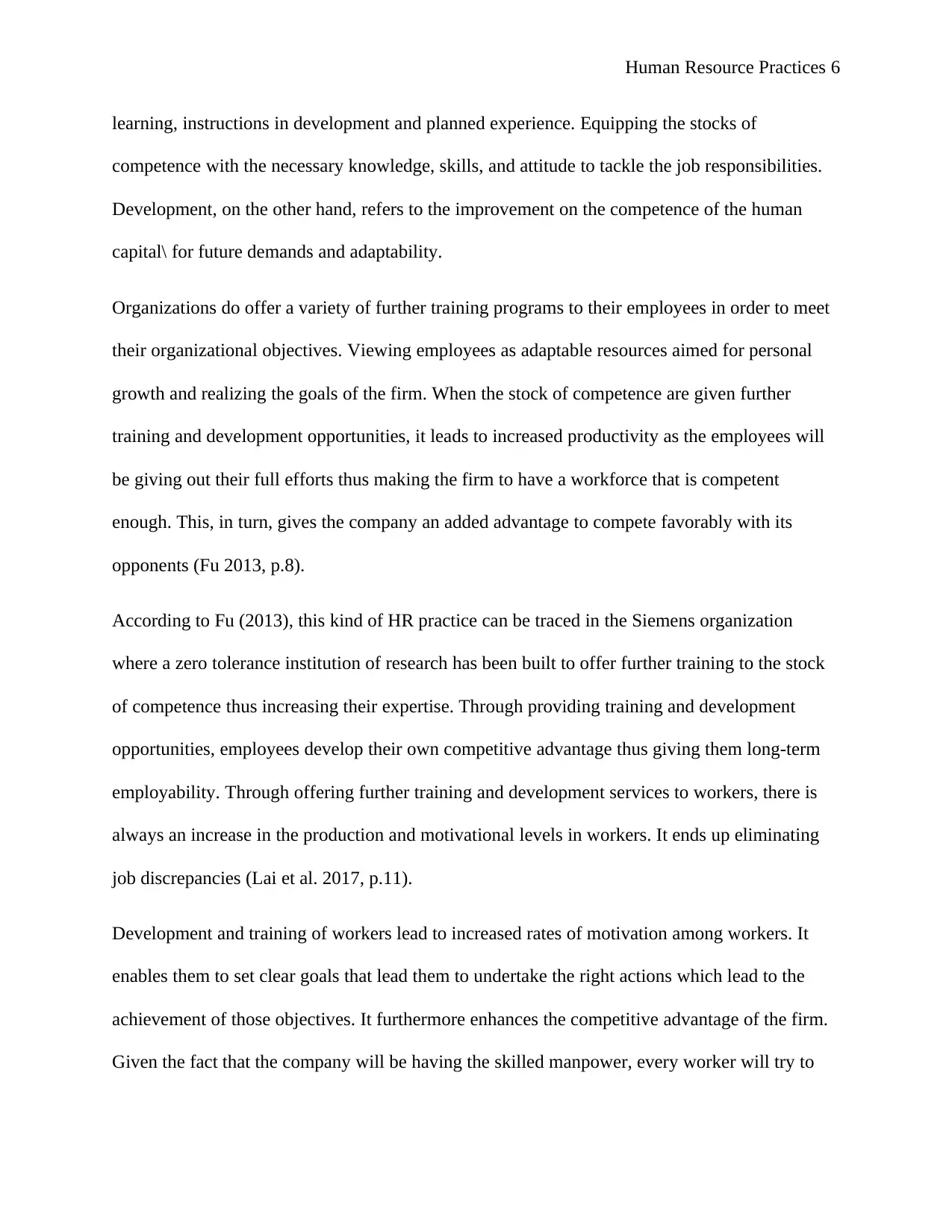
Human Resource Practices 6
learning, instructions in development and planned experience. Equipping the stocks of
competence with the necessary knowledge, skills, and attitude to tackle the job responsibilities.
Development, on the other hand, refers to the improvement on the competence of the human
capital\ for future demands and adaptability.
Organizations do offer a variety of further training programs to their employees in order to meet
their organizational objectives. Viewing employees as adaptable resources aimed for personal
growth and realizing the goals of the firm. When the stock of competence are given further
training and development opportunities, it leads to increased productivity as the employees will
be giving out their full efforts thus making the firm to have a workforce that is competent
enough. This, in turn, gives the company an added advantage to compete favorably with its
opponents (Fu 2013, p.8).
According to Fu (2013), this kind of HR practice can be traced in the Siemens organization
where a zero tolerance institution of research has been built to offer further training to the stock
of competence thus increasing their expertise. Through providing training and development
opportunities, employees develop their own competitive advantage thus giving them long-term
employability. Through offering further training and development services to workers, there is
always an increase in the production and motivational levels in workers. It ends up eliminating
job discrepancies (Lai et al. 2017, p.11).
Development and training of workers lead to increased rates of motivation among workers. It
enables them to set clear goals that lead them to undertake the right actions which lead to the
achievement of those objectives. It furthermore enhances the competitive advantage of the firm.
Given the fact that the company will be having the skilled manpower, every worker will try to
learning, instructions in development and planned experience. Equipping the stocks of
competence with the necessary knowledge, skills, and attitude to tackle the job responsibilities.
Development, on the other hand, refers to the improvement on the competence of the human
capital\ for future demands and adaptability.
Organizations do offer a variety of further training programs to their employees in order to meet
their organizational objectives. Viewing employees as adaptable resources aimed for personal
growth and realizing the goals of the firm. When the stock of competence are given further
training and development opportunities, it leads to increased productivity as the employees will
be giving out their full efforts thus making the firm to have a workforce that is competent
enough. This, in turn, gives the company an added advantage to compete favorably with its
opponents (Fu 2013, p.8).
According to Fu (2013), this kind of HR practice can be traced in the Siemens organization
where a zero tolerance institution of research has been built to offer further training to the stock
of competence thus increasing their expertise. Through providing training and development
opportunities, employees develop their own competitive advantage thus giving them long-term
employability. Through offering further training and development services to workers, there is
always an increase in the production and motivational levels in workers. It ends up eliminating
job discrepancies (Lai et al. 2017, p.11).
Development and training of workers lead to increased rates of motivation among workers. It
enables them to set clear goals that lead them to undertake the right actions which lead to the
achievement of those objectives. It furthermore enhances the competitive advantage of the firm.
Given the fact that the company will be having the skilled manpower, every worker will try to
⊘ This is a preview!⊘
Do you want full access?
Subscribe today to unlock all pages.

Trusted by 1+ million students worldwide
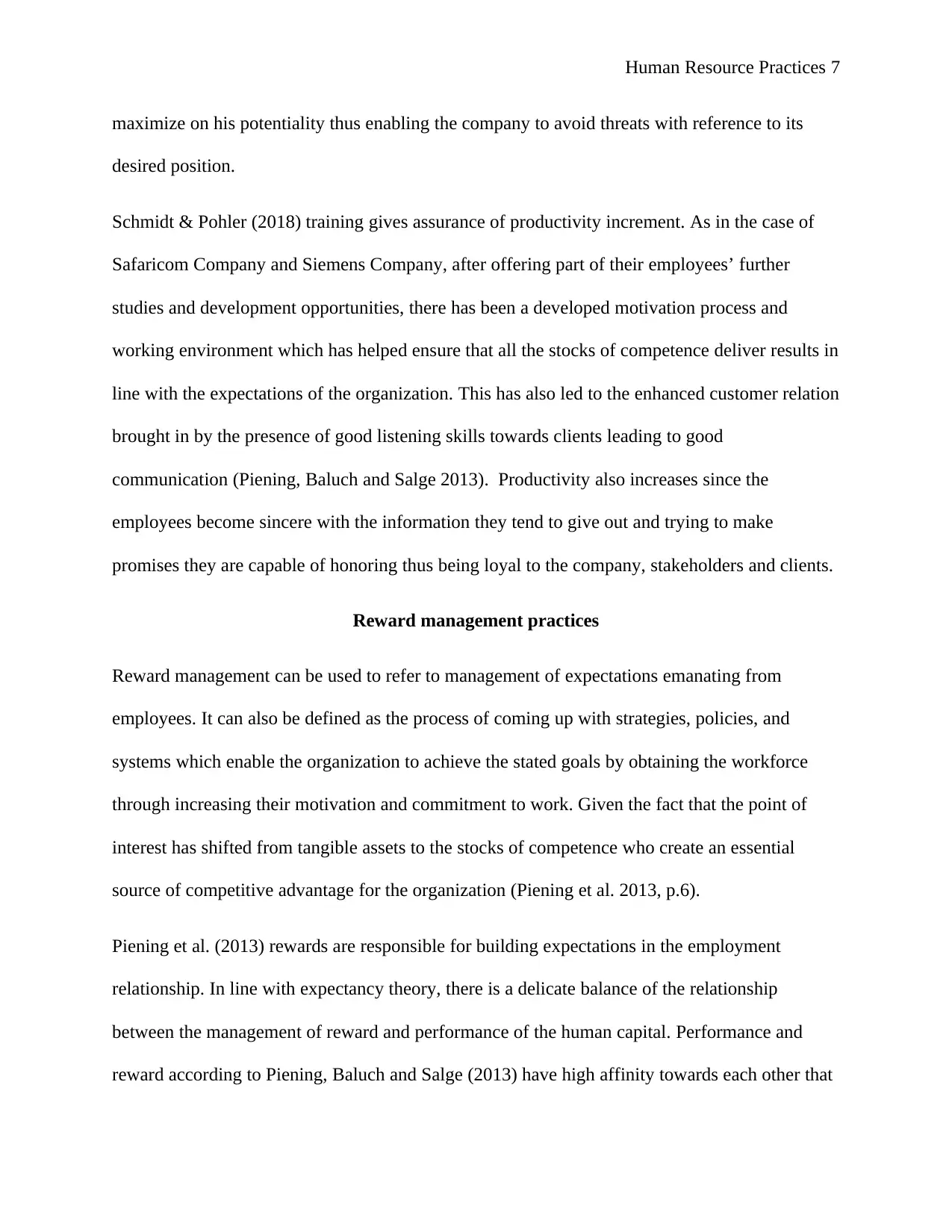
Human Resource Practices 7
maximize on his potentiality thus enabling the company to avoid threats with reference to its
desired position.
Schmidt & Pohler (2018) training gives assurance of productivity increment. As in the case of
Safaricom Company and Siemens Company, after offering part of their employees’ further
studies and development opportunities, there has been a developed motivation process and
working environment which has helped ensure that all the stocks of competence deliver results in
line with the expectations of the organization. This has also led to the enhanced customer relation
brought in by the presence of good listening skills towards clients leading to good
communication (Piening, Baluch and Salge 2013). Productivity also increases since the
employees become sincere with the information they tend to give out and trying to make
promises they are capable of honoring thus being loyal to the company, stakeholders and clients.
Reward management practices
Reward management can be used to refer to management of expectations emanating from
employees. It can also be defined as the process of coming up with strategies, policies, and
systems which enable the organization to achieve the stated goals by obtaining the workforce
through increasing their motivation and commitment to work. Given the fact that the point of
interest has shifted from tangible assets to the stocks of competence who create an essential
source of competitive advantage for the organization (Piening et al. 2013, p.6).
Piening et al. (2013) rewards are responsible for building expectations in the employment
relationship. In line with expectancy theory, there is a delicate balance of the relationship
between the management of reward and performance of the human capital. Performance and
reward according to Piening, Baluch and Salge (2013) have high affinity towards each other that
maximize on his potentiality thus enabling the company to avoid threats with reference to its
desired position.
Schmidt & Pohler (2018) training gives assurance of productivity increment. As in the case of
Safaricom Company and Siemens Company, after offering part of their employees’ further
studies and development opportunities, there has been a developed motivation process and
working environment which has helped ensure that all the stocks of competence deliver results in
line with the expectations of the organization. This has also led to the enhanced customer relation
brought in by the presence of good listening skills towards clients leading to good
communication (Piening, Baluch and Salge 2013). Productivity also increases since the
employees become sincere with the information they tend to give out and trying to make
promises they are capable of honoring thus being loyal to the company, stakeholders and clients.
Reward management practices
Reward management can be used to refer to management of expectations emanating from
employees. It can also be defined as the process of coming up with strategies, policies, and
systems which enable the organization to achieve the stated goals by obtaining the workforce
through increasing their motivation and commitment to work. Given the fact that the point of
interest has shifted from tangible assets to the stocks of competence who create an essential
source of competitive advantage for the organization (Piening et al. 2013, p.6).
Piening et al. (2013) rewards are responsible for building expectations in the employment
relationship. In line with expectancy theory, there is a delicate balance of the relationship
between the management of reward and performance of the human capital. Performance and
reward according to Piening, Baluch and Salge (2013) have high affinity towards each other that
Paraphrase This Document
Need a fresh take? Get an instant paraphrase of this document with our AI Paraphraser
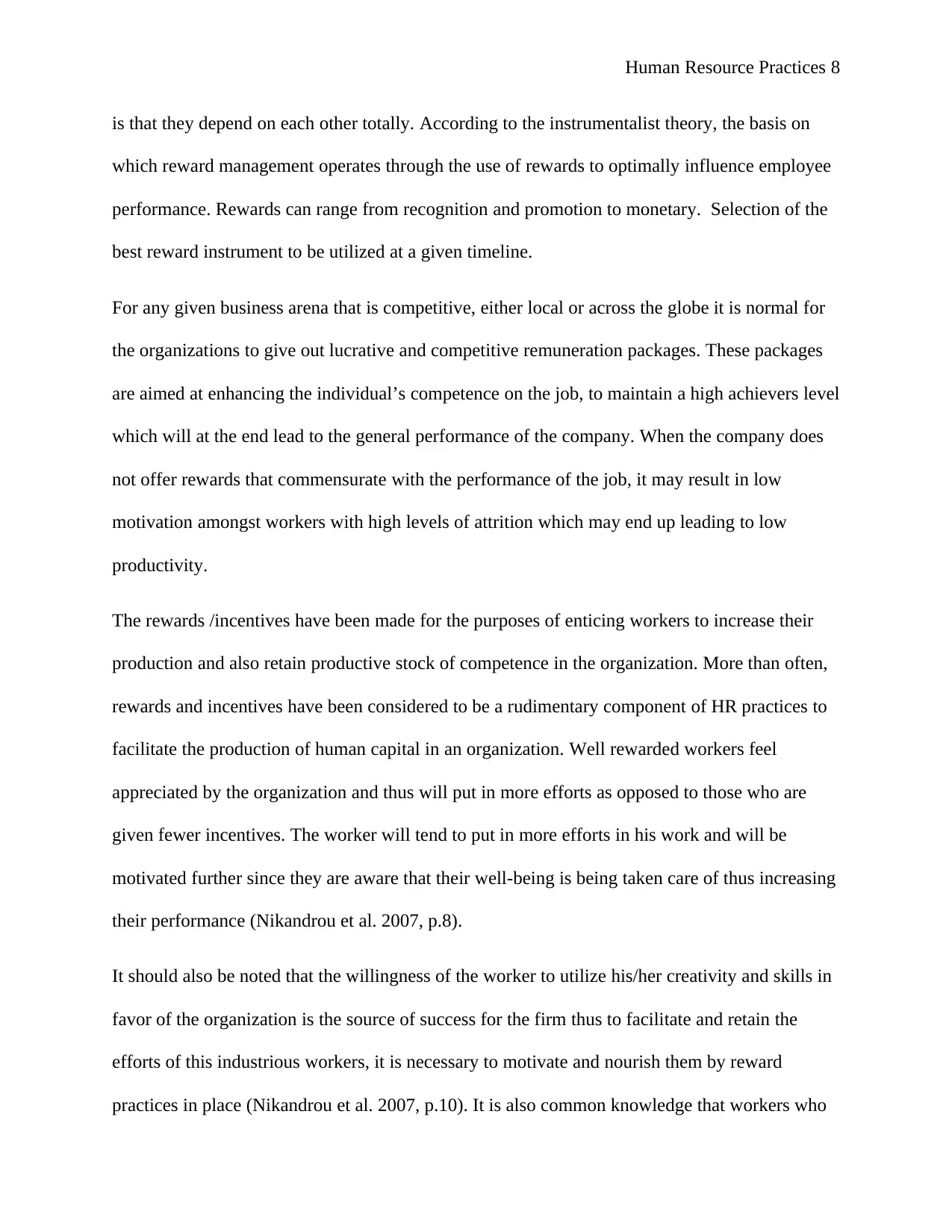
Human Resource Practices 8
is that they depend on each other totally. According to the instrumentalist theory, the basis on
which reward management operates through the use of rewards to optimally influence employee
performance. Rewards can range from recognition and promotion to monetary. Selection of the
best reward instrument to be utilized at a given timeline.
For any given business arena that is competitive, either local or across the globe it is normal for
the organizations to give out lucrative and competitive remuneration packages. These packages
are aimed at enhancing the individual’s competence on the job, to maintain a high achievers level
which will at the end lead to the general performance of the company. When the company does
not offer rewards that commensurate with the performance of the job, it may result in low
motivation amongst workers with high levels of attrition which may end up leading to low
productivity.
The rewards /incentives have been made for the purposes of enticing workers to increase their
production and also retain productive stock of competence in the organization. More than often,
rewards and incentives have been considered to be a rudimentary component of HR practices to
facilitate the production of human capital in an organization. Well rewarded workers feel
appreciated by the organization and thus will put in more efforts as opposed to those who are
given fewer incentives. The worker will tend to put in more efforts in his work and will be
motivated further since they are aware that their well-being is being taken care of thus increasing
their performance (Nikandrou et al. 2007, p.8).
It should also be noted that the willingness of the worker to utilize his/her creativity and skills in
favor of the organization is the source of success for the firm thus to facilitate and retain the
efforts of this industrious workers, it is necessary to motivate and nourish them by reward
practices in place (Nikandrou et al. 2007, p.10). It is also common knowledge that workers who
is that they depend on each other totally. According to the instrumentalist theory, the basis on
which reward management operates through the use of rewards to optimally influence employee
performance. Rewards can range from recognition and promotion to monetary. Selection of the
best reward instrument to be utilized at a given timeline.
For any given business arena that is competitive, either local or across the globe it is normal for
the organizations to give out lucrative and competitive remuneration packages. These packages
are aimed at enhancing the individual’s competence on the job, to maintain a high achievers level
which will at the end lead to the general performance of the company. When the company does
not offer rewards that commensurate with the performance of the job, it may result in low
motivation amongst workers with high levels of attrition which may end up leading to low
productivity.
The rewards /incentives have been made for the purposes of enticing workers to increase their
production and also retain productive stock of competence in the organization. More than often,
rewards and incentives have been considered to be a rudimentary component of HR practices to
facilitate the production of human capital in an organization. Well rewarded workers feel
appreciated by the organization and thus will put in more efforts as opposed to those who are
given fewer incentives. The worker will tend to put in more efforts in his work and will be
motivated further since they are aware that their well-being is being taken care of thus increasing
their performance (Nikandrou et al. 2007, p.8).
It should also be noted that the willingness of the worker to utilize his/her creativity and skills in
favor of the organization is the source of success for the firm thus to facilitate and retain the
efforts of this industrious workers, it is necessary to motivate and nourish them by reward
practices in place (Nikandrou et al. 2007, p.10). It is also common knowledge that workers who
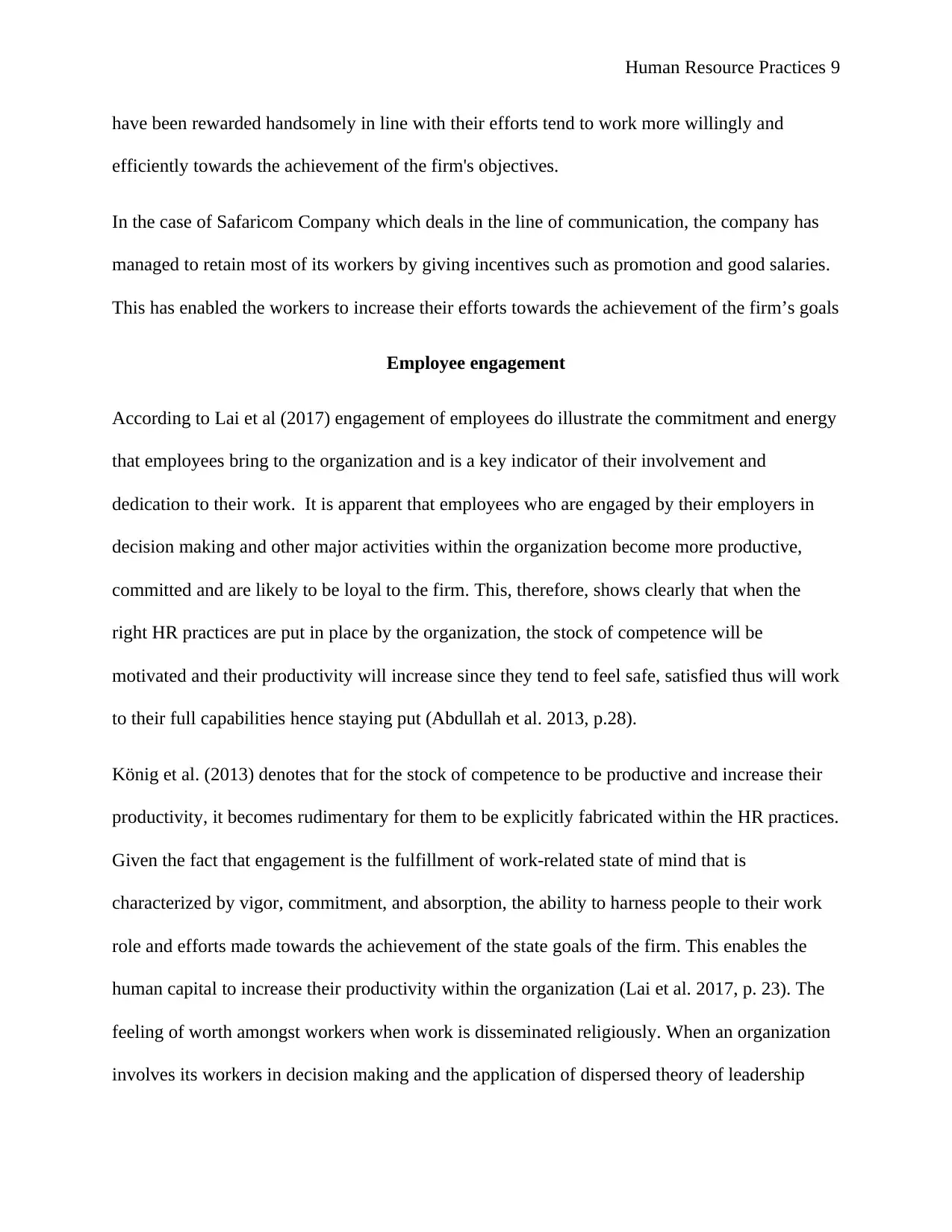
Human Resource Practices 9
have been rewarded handsomely in line with their efforts tend to work more willingly and
efficiently towards the achievement of the firm's objectives.
In the case of Safaricom Company which deals in the line of communication, the company has
managed to retain most of its workers by giving incentives such as promotion and good salaries.
This has enabled the workers to increase their efforts towards the achievement of the firm’s goals
Employee engagement
According to Lai et al (2017) engagement of employees do illustrate the commitment and energy
that employees bring to the organization and is a key indicator of their involvement and
dedication to their work. It is apparent that employees who are engaged by their employers in
decision making and other major activities within the organization become more productive,
committed and are likely to be loyal to the firm. This, therefore, shows clearly that when the
right HR practices are put in place by the organization, the stock of competence will be
motivated and their productivity will increase since they tend to feel safe, satisfied thus will work
to their full capabilities hence staying put (Abdullah et al. 2013, p.28).
König et al. (2013) denotes that for the stock of competence to be productive and increase their
productivity, it becomes rudimentary for them to be explicitly fabricated within the HR practices.
Given the fact that engagement is the fulfillment of work-related state of mind that is
characterized by vigor, commitment, and absorption, the ability to harness people to their work
role and efforts made towards the achievement of the state goals of the firm. This enables the
human capital to increase their productivity within the organization (Lai et al. 2017, p. 23). The
feeling of worth amongst workers when work is disseminated religiously. When an organization
involves its workers in decision making and the application of dispersed theory of leadership
have been rewarded handsomely in line with their efforts tend to work more willingly and
efficiently towards the achievement of the firm's objectives.
In the case of Safaricom Company which deals in the line of communication, the company has
managed to retain most of its workers by giving incentives such as promotion and good salaries.
This has enabled the workers to increase their efforts towards the achievement of the firm’s goals
Employee engagement
According to Lai et al (2017) engagement of employees do illustrate the commitment and energy
that employees bring to the organization and is a key indicator of their involvement and
dedication to their work. It is apparent that employees who are engaged by their employers in
decision making and other major activities within the organization become more productive,
committed and are likely to be loyal to the firm. This, therefore, shows clearly that when the
right HR practices are put in place by the organization, the stock of competence will be
motivated and their productivity will increase since they tend to feel safe, satisfied thus will work
to their full capabilities hence staying put (Abdullah et al. 2013, p.28).
König et al. (2013) denotes that for the stock of competence to be productive and increase their
productivity, it becomes rudimentary for them to be explicitly fabricated within the HR practices.
Given the fact that engagement is the fulfillment of work-related state of mind that is
characterized by vigor, commitment, and absorption, the ability to harness people to their work
role and efforts made towards the achievement of the state goals of the firm. This enables the
human capital to increase their productivity within the organization (Lai et al. 2017, p. 23). The
feeling of worth amongst workers when work is disseminated religiously. When an organization
involves its workers in decision making and the application of dispersed theory of leadership
⊘ This is a preview!⊘
Do you want full access?
Subscribe today to unlock all pages.

Trusted by 1+ million students worldwide
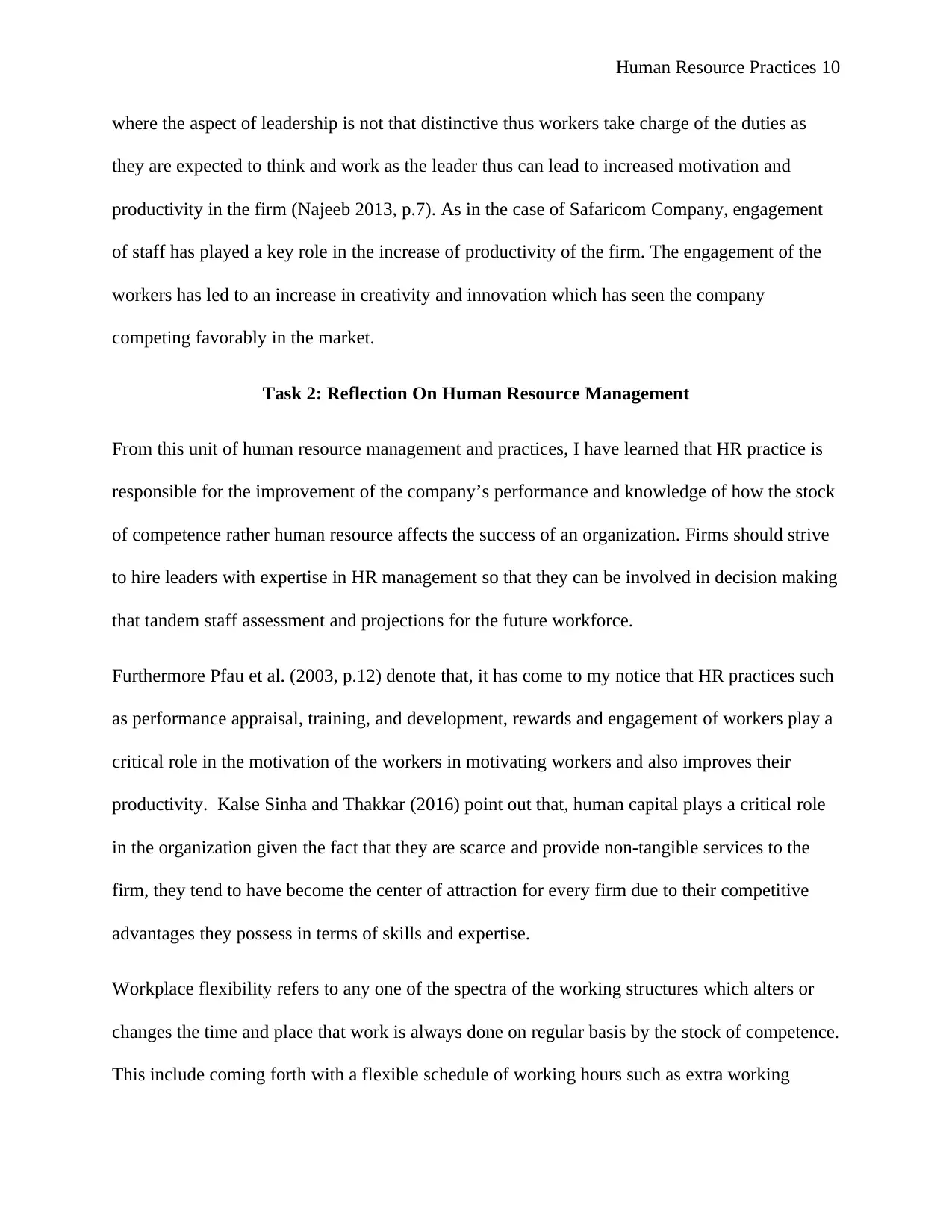
Human Resource Practices 10
where the aspect of leadership is not that distinctive thus workers take charge of the duties as
they are expected to think and work as the leader thus can lead to increased motivation and
productivity in the firm (Najeeb 2013, p.7). As in the case of Safaricom Company, engagement
of staff has played a key role in the increase of productivity of the firm. The engagement of the
workers has led to an increase in creativity and innovation which has seen the company
competing favorably in the market.
Task 2: Reflection On Human Resource Management
From this unit of human resource management and practices, I have learned that HR practice is
responsible for the improvement of the company’s performance and knowledge of how the stock
of competence rather human resource affects the success of an organization. Firms should strive
to hire leaders with expertise in HR management so that they can be involved in decision making
that tandem staff assessment and projections for the future workforce.
Furthermore Pfau et al. (2003, p.12) denote that, it has come to my notice that HR practices such
as performance appraisal, training, and development, rewards and engagement of workers play a
critical role in the motivation of the workers in motivating workers and also improves their
productivity. Kalse Sinha and Thakkar (2016) point out that, human capital plays a critical role
in the organization given the fact that they are scarce and provide non-tangible services to the
firm, they tend to have become the center of attraction for every firm due to their competitive
advantages they possess in terms of skills and expertise.
Workplace flexibility refers to any one of the spectra of the working structures which alters or
changes the time and place that work is always done on regular basis by the stock of competence.
This include coming forth with a flexible schedule of working hours such as extra working
where the aspect of leadership is not that distinctive thus workers take charge of the duties as
they are expected to think and work as the leader thus can lead to increased motivation and
productivity in the firm (Najeeb 2013, p.7). As in the case of Safaricom Company, engagement
of staff has played a key role in the increase of productivity of the firm. The engagement of the
workers has led to an increase in creativity and innovation which has seen the company
competing favorably in the market.
Task 2: Reflection On Human Resource Management
From this unit of human resource management and practices, I have learned that HR practice is
responsible for the improvement of the company’s performance and knowledge of how the stock
of competence rather human resource affects the success of an organization. Firms should strive
to hire leaders with expertise in HR management so that they can be involved in decision making
that tandem staff assessment and projections for the future workforce.
Furthermore Pfau et al. (2003, p.12) denote that, it has come to my notice that HR practices such
as performance appraisal, training, and development, rewards and engagement of workers play a
critical role in the motivation of the workers in motivating workers and also improves their
productivity. Kalse Sinha and Thakkar (2016) point out that, human capital plays a critical role
in the organization given the fact that they are scarce and provide non-tangible services to the
firm, they tend to have become the center of attraction for every firm due to their competitive
advantages they possess in terms of skills and expertise.
Workplace flexibility refers to any one of the spectra of the working structures which alters or
changes the time and place that work is always done on regular basis by the stock of competence.
This include coming forth with a flexible schedule of working hours such as extra working
Paraphrase This Document
Need a fresh take? Get an instant paraphrase of this document with our AI Paraphraser
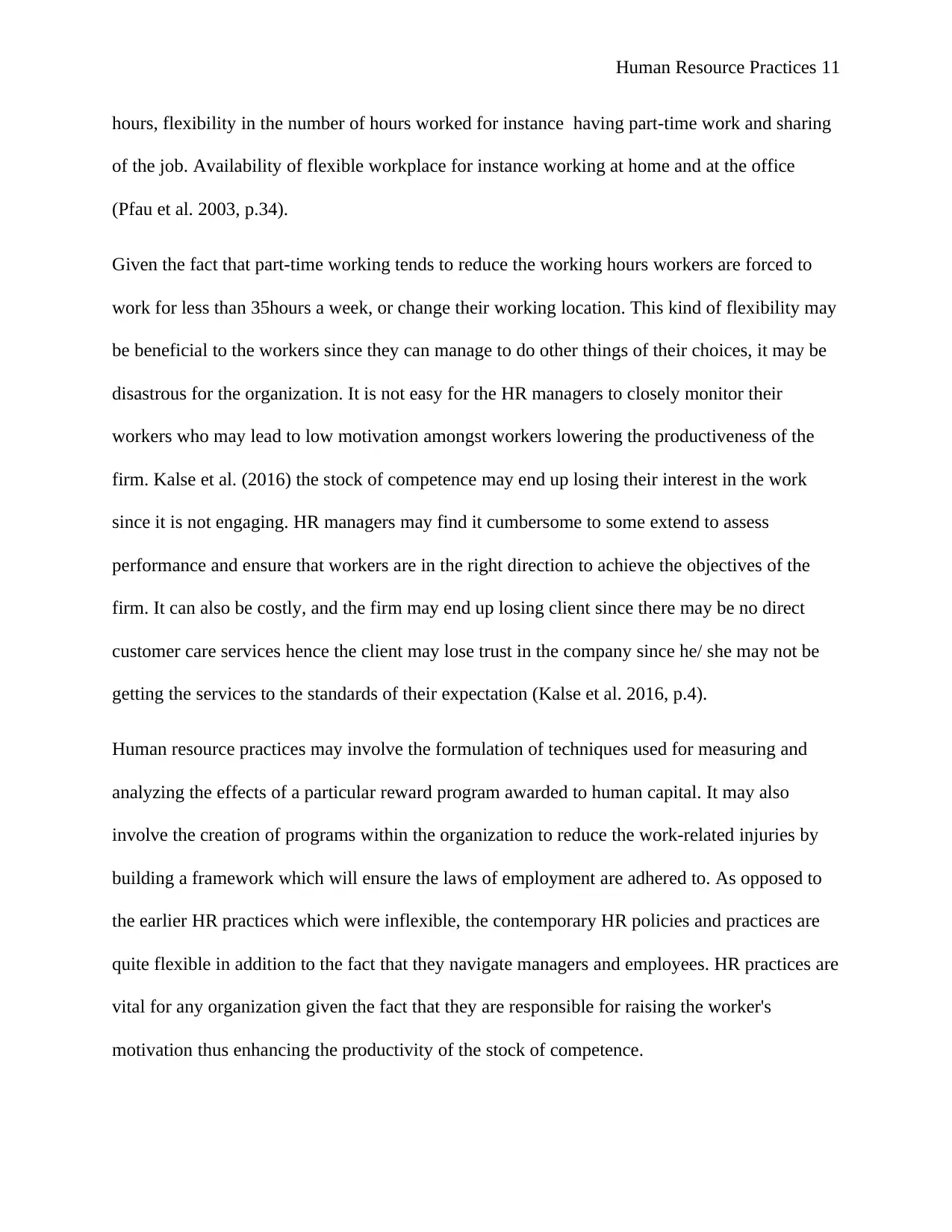
Human Resource Practices 11
hours, flexibility in the number of hours worked for instance having part-time work and sharing
of the job. Availability of flexible workplace for instance working at home and at the office
(Pfau et al. 2003, p.34).
Given the fact that part-time working tends to reduce the working hours workers are forced to
work for less than 35hours a week, or change their working location. This kind of flexibility may
be beneficial to the workers since they can manage to do other things of their choices, it may be
disastrous for the organization. It is not easy for the HR managers to closely monitor their
workers who may lead to low motivation amongst workers lowering the productiveness of the
firm. Kalse et al. (2016) the stock of competence may end up losing their interest in the work
since it is not engaging. HR managers may find it cumbersome to some extend to assess
performance and ensure that workers are in the right direction to achieve the objectives of the
firm. It can also be costly, and the firm may end up losing client since there may be no direct
customer care services hence the client may lose trust in the company since he/ she may not be
getting the services to the standards of their expectation (Kalse et al. 2016, p.4).
Human resource practices may involve the formulation of techniques used for measuring and
analyzing the effects of a particular reward program awarded to human capital. It may also
involve the creation of programs within the organization to reduce the work-related injuries by
building a framework which will ensure the laws of employment are adhered to. As opposed to
the earlier HR practices which were inflexible, the contemporary HR policies and practices are
quite flexible in addition to the fact that they navigate managers and employees. HR practices are
vital for any organization given the fact that they are responsible for raising the worker's
motivation thus enhancing the productivity of the stock of competence.
hours, flexibility in the number of hours worked for instance having part-time work and sharing
of the job. Availability of flexible workplace for instance working at home and at the office
(Pfau et al. 2003, p.34).
Given the fact that part-time working tends to reduce the working hours workers are forced to
work for less than 35hours a week, or change their working location. This kind of flexibility may
be beneficial to the workers since they can manage to do other things of their choices, it may be
disastrous for the organization. It is not easy for the HR managers to closely monitor their
workers who may lead to low motivation amongst workers lowering the productiveness of the
firm. Kalse et al. (2016) the stock of competence may end up losing their interest in the work
since it is not engaging. HR managers may find it cumbersome to some extend to assess
performance and ensure that workers are in the right direction to achieve the objectives of the
firm. It can also be costly, and the firm may end up losing client since there may be no direct
customer care services hence the client may lose trust in the company since he/ she may not be
getting the services to the standards of their expectation (Kalse et al. 2016, p.4).
Human resource practices may involve the formulation of techniques used for measuring and
analyzing the effects of a particular reward program awarded to human capital. It may also
involve the creation of programs within the organization to reduce the work-related injuries by
building a framework which will ensure the laws of employment are adhered to. As opposed to
the earlier HR practices which were inflexible, the contemporary HR policies and practices are
quite flexible in addition to the fact that they navigate managers and employees. HR practices are
vital for any organization given the fact that they are responsible for raising the worker's
motivation thus enhancing the productivity of the stock of competence.
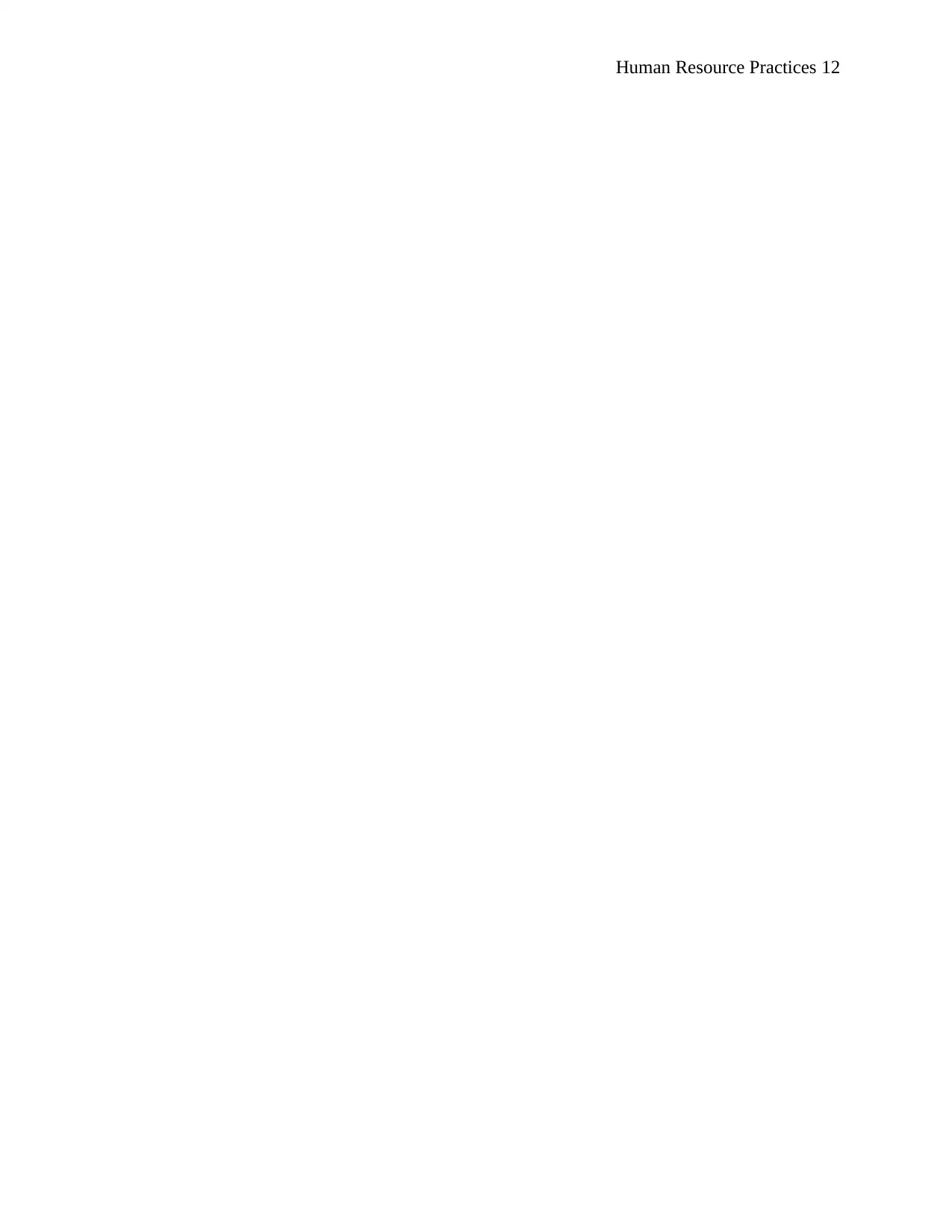
Human Resource Practices 12
⊘ This is a preview!⊘
Do you want full access?
Subscribe today to unlock all pages.

Trusted by 1+ million students worldwide
1 out of 14
Related Documents
Your All-in-One AI-Powered Toolkit for Academic Success.
+13062052269
info@desklib.com
Available 24*7 on WhatsApp / Email
![[object Object]](/_next/static/media/star-bottom.7253800d.svg)
Unlock your academic potential
Copyright © 2020–2025 A2Z Services. All Rights Reserved. Developed and managed by ZUCOL.





